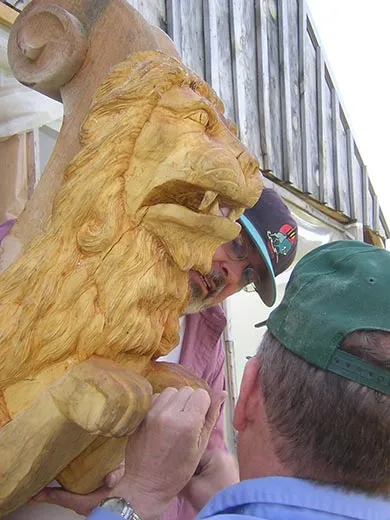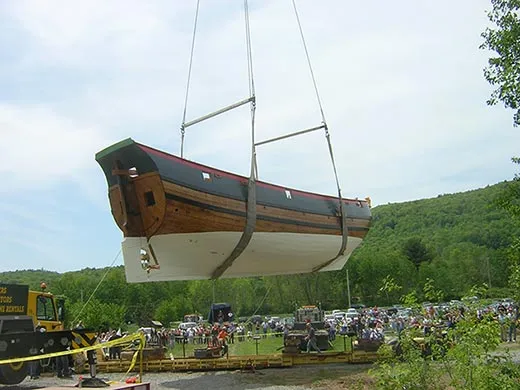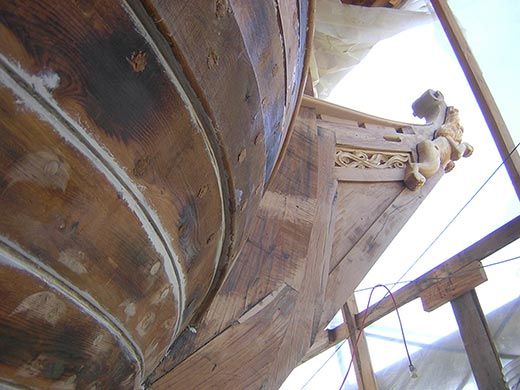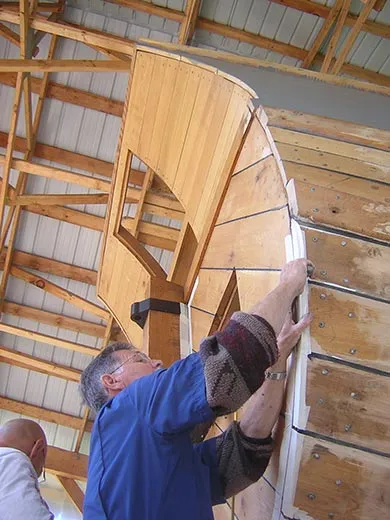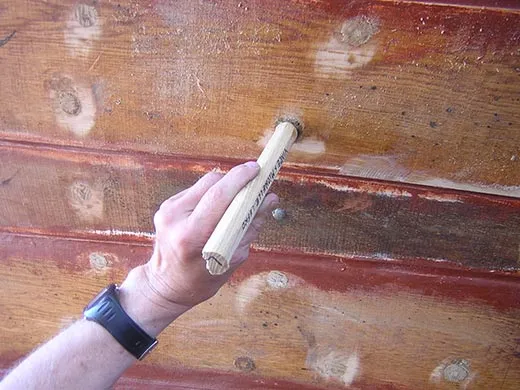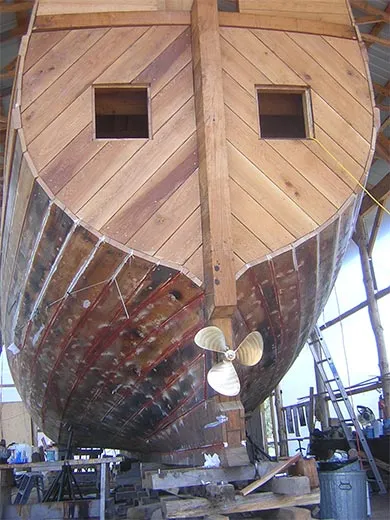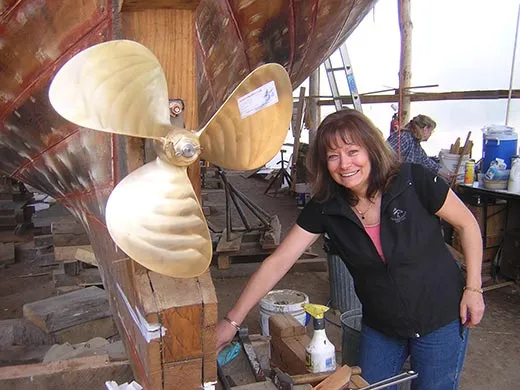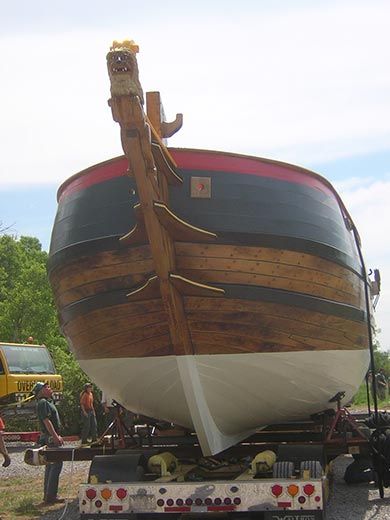Setting Sail on the Hudson River 400 Years Later
Using 17th century techniques, volunteers built a replica of Henry Hudson’s vessel in honor of the anniversary of his exploration
/https://tf-cmsv2-smithsonianmag-media.s3.amazonaws.com/filer/the-Onrust-shipbuilding-631.jpg)
About midway through construction of the replica of Onrust, a 17th-century Dutch ship, volunteer Lance LaTant of Queensbury, New York, paused and peered through a thicket of curved, bent white oak ribs towering over him and fellow workers. "It looked like a beached whale with bleached bones," he recalled. It was clear that finishing and launching the 52-foot, 29-ton boat in a year would be a challenge for the volunteer builders.
But hard work and a little luck paid off. On June 6 the Onrust (pronounced AHN-roost) reproduction joins a flotilla of some 15 historic vessels and untold numbers of private and commercial boats sailing from Manhattan 140 miles up the Hudson River to Albany to mark the 400th anniversary of Henry Hudson's 1609 journey up the river. The weeklong voyage includes the 85-foot, three-masted replica of Hudson's ship Half Moon, a West Point 16-gun salute and an antique biplane flyover. Towns along the Hudson will ring church bells, sound whistles and organize waterside public events
Flying three colorful Dutch flags and sporting a hand-carved figurehead of a snarling white-maned lion, Onrust takes a prominent place in the quadricentennial's parade of ships even though its original was built in 1614, a few years after Hudson's historic voyage. The original Onrust was the first covered deck ship ever built in the area that would one day become New York, and it played a key role in shaping New York's history.
Hudson, an English explorer hired by the Dutch, sailed up the river later named for him in his third attempt to find a passage to China. Laying claim to the territory, the Dutch encouraged investment and colonization. Adriaen Block, captain of the original Onrust, "was a merchant captain sent over here to exploit resources that Hudson had accidentally opened up," said Charles T. Gehring, director of the New Netherland Project in Albany.
The Onrust replica took nearly three years to construct, but the original Onrust (which means "trouble" in Dutch) went up in about six months after Block's ship Tyger was destroyed by fire. Anxious to take advantage of the New World's riches, Block's crew worked on the ship through the frigid winter of 1614, most likely on the tip of Manhattan or nearby Governors Island. The shipwright who built Tyger probably oversaw the construction and salvaged lumber from the charred boat.
With his new ship Onrust, Block mapped much of the territory he would name New Netherland; it extended from the current-day mid-Atlantic region up into the New England states. The ship's shallow draft allowed Block to poke into bays, inlets and rivers to visit potential trading partners. By mapping Native American villages, he helped establish a bustling fur trading network with the various tribes in the region. "Onrust and Block are the real start of European history in New York," said project president Don Rittner, "but Block never got the credit he deserved and that's one big reason for making the replica."
To get the ship built in time for the celebration, some 20 core volunteers, mostly from the Dutch-settled Albany region, worked 12-hour shifts, seven days a week throughout the winter in a heated pole barn in Rotterdam Junction, New York.
Guided by Gerald de Weerdt, a maritime museum curator from Holland, the volunteers relied on meticulous historic research because no blueprints of the ship were ever made.
"What you need for a ship like this is a drawing, but that didn't exist," says de Weerdt. "They didn't know how to draw them." He tracked down dimensions of similar historic boats—with sleek yacht-style fish-shaped hulls—in old books and archives in Holland. He studied 17th-century Dutch shipwrecks exposed in the clay beds of Holland's inner sea after it was drained over a 40-year period starting after World War II. De Weerdt clinched his research by perusing old paintings and engravings of early yachts built to fight the Spanish war fleet in the North Sea.
Onrust volunteers—welders, machinists, chemists, teachers, artists; women and children—all seemed to share a love of history or boats, or both. In all, 250 of them worked to get the ship on the water.
"I had plans to build an Adirondack guide boat but I decided to do this instead," said LaTant, a retired General Electric plastics design manager. He commuted 60 miles from the Lake George area and camped out for weeks at a time near the ship.
In homage to authenticity, the builders used wooden nails—4,000 of them—and bent oak planks the old-fashioned way, by wetting the wood and heating it with fire. "I cut a plank and bent it myself and that gives me a plank in the ship and bragging rights," said retired nurse Debbie Bowdish of Princetown. Her husband George sawed the ship's 45-foot-tall tamarack mast, the boom and at least 100 ancient white oaks for the ship. Close to the end of the job, volunteers ran out of old oak, but luckily a developer donated eight 300-year-old trees.
The $3 million project was financed by the Dutch government, New York state, individual donations, corporate grants, and many gifts of services and equipment such as hinges, anchors and even cannons.
Finally, just days ago, the Onrust was hoisted on a flatbed truck to move it out of the barn, but the truck couldn't budge it. It took volunteer Frank Del Gallo, a swimming pool builder, and one of his bulldozers to do the trick. A crane then lifted the ship and placed it in the water. With that, the new Onrust began its tribute to an historic past.
Editor’s Note: The Onrust will return to New York in September, joining a Dutch government flotilla of modern warships and 17th-century-style flat-bottomed boats brought to New York on freighters for the quadricentennial celebration. After the festivities, Onrust will continue sailing upstate and elsewhere as a floating classroom to teach early American Dutch history.
